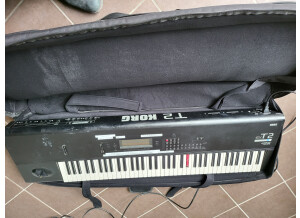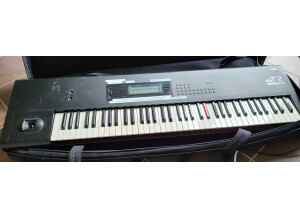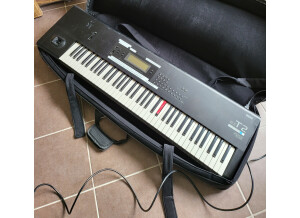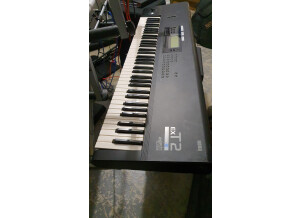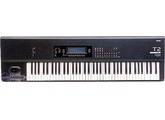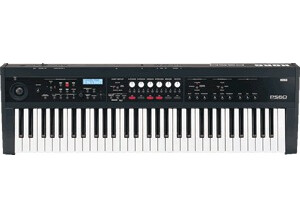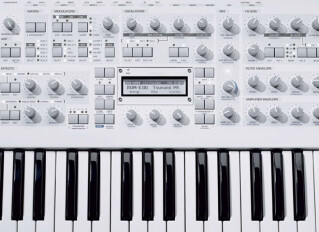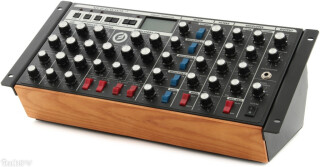T2 Ex classified ad
Alerte nouvelle annonceImages
Videos
Reviews
4.0/5(1 reviews)
100 %
Write a user review
An M1 on steroids
Published on 04/07/18 at 15:13In 1991, Korg debuted the T series with three different versions: the T1 (88 keys), T2 (76 keys) and T3 (61 keys). The Ex versions – "T2ex" and "T3ex" – feature an extra ROM with 512 kb of PCM acoustic piano sounds, the best you could get at the time, which was originally featured on the T1 model.
Introduction
The T series succeeded to Korg’s famous M1, aka the best-selling synth ever and the first general public workstation.
It features an 8-track sequencer, 16 tracks of polyphony and dual multi-effect inside. The T series’ sound engine is the same as the M1’s, and the patches are even compatible with one another. It’s a subtractive synthesis ROMpler, with the sound part taken care of...…
Introduction
The T series succeeded to Korg’s famous M1, aka the best-selling synth ever and the first general public workstation.
It features an 8-track sequencer, 16 tracks of polyphony and dual multi-effect inside. The T series’ sound engine is the same as the M1’s, and the patches are even compatible with one another. It’s a subtractive synthesis ROMpler, with the sound part taken care of...…
Read more
In 1991, Korg debuted the T series with three different versions: the T1 (88 keys), T2 (76 keys) and T3 (61 keys). The Ex versions – "T2ex" and "T3ex" – feature an extra ROM with 512 kb of PCM acoustic piano sounds, the best you could get at the time, which was originally featured on the T1 model.
Introduction
The T series succeeded to Korg’s famous M1, aka the best-selling synth ever and the first general public workstation.
It features an 8-track sequencer, 16 tracks of polyphony and dual multi-effect inside. The T series’ sound engine is the same as the M1’s, and the patches are even compatible with one another. It’s a subtractive synthesis ROMpler, with the sound part taken care of by PCM samples (4MB for 144 samples).
The T, aka the “M1 on steroids”, features a larger screen, a floppy disk drive, two additional 100-patch banks, and 8MB of waveform (instead of 4MB).
With a price of 200 to 250€, its current value-for-money on the used market is very good.
Apart from its manufacturing quality, it features the punchy sound of the synths of its time, such as the D50 or Wavestation. Its dynamics is a pleasant surprise, in particular in the lower register with powerful and precise bass sounds that don’t crumble down. The output provides very little hiss or noise.
Soundwise
Its strength resides in the versatility and variety of its available sounds, with a palette ranging from synth sounds (bass, leads, pads, FX) to “realistic” instrument sounds – though their “realism” now appears quite debatable. In a nutshell, the synth can reproduce every General MIDI instrument (piano, organ, strings, winds etc...) with a quality only slightly better than GM sounds, so as a whole it sounds cheap. However, some patches are worth a listen, plus you’ll easily something fit for you among the numerous (20,000+) sysex patches available on the web.
The user has 2 banks of 100 single patches each, “PROG A” and “PROG B”, plus an extra “Combi” 100-patch bank.
- each Combi is made of 8 single patches or 8 multitimbral parts that can be used at taste (as a separate instrument, keyboard split or layering modes). I personally use layering quite a lot, by mixing 3 or 4 carefully chosen sounds you can easily enrich the basic sounds.
For those into it, it’s an occasion to buy a piece of legend.
The M1’s sound has contributed to write uncountable hits of all kinds in the beginning of the 90s, in styles including pop ballads, synth pop, pop, radio rock, house, new beat, jungle, techno, hip-hop, dance, ambiant, ethnic, TV themes and so on...
In terms of synth sounds, the result is quite basic but it provides generous lows.
- a variety of nice pads
- synth brass
- analog synth-type bass
- convincingly-sounding leads
- son percussive sounds and FX
As to the realistic sounds:
- the typical 80s drum sounds are awesome, full of punch
- the Hammond, Rhodes and church organs are not bad, especially the mythical “M1organ” from Robin S – Show Me Love fame
- beautiful LA piano sounds (piano + strings)
- pianos are little realistic but perfectly suit piano house, italo disco, new beat or old school jungle registers
- cheap sax sounds which still work in an old school house or hip-hop context
- 1 electric guitar patch with an igniting feedback, very nice to play (6-7 minutes into the demo down the page)
- Convincing acoustic guitars
- 2 or 3 convincing slap basses
- Some nice sounding clavinets
Pros
+ overall sound quality, punch with little background noise, lush bass sounds typical of Korg’s old synths
+ many patches available on the internet, and various sounds
+ easy to program, good ergonomics (except for the sequencer)
+ a good, minimalistic design, sturdy with its metal frame
+ 4 separate jack outputs
+ 4 MIDI outs + MIDI in and Thru
+ pleasant keyboard with aftertouch and joystick
Cons
- no arpeggiator
- non-resoning filter
- the sequencer part (its ergonomics and editing features lack something)
- among all available patches, many sound poor and General Midi-like
- quite a big keyboard
- when aging, the backlight tends to diminish and disappear. When it happens, it can come with a trebly noise coming from the synth’s frame (and not the audio outs), which comes from the voltage inverter which supplies the backlight with 12V. It’s a well-known problem on synth with an electroluminescent leaf-type (“EL”) backlight (such as the Wavestation, Kawai K5000, Yamaha SY and TG, K2000, Korg 01W...). The backlight and inverter can be changed, or the entire screen changed for a LED model.
- sometimes, disconnecting the backlight’s supply (CN6 connector with two wires, plugged on the KMI-077 supply board) stops the said noise
- with time, the switches tend to do what they like (but they can be changed)
In the end…
If you listen to the demo, you’ll get an idea of the patches on the KORG Legacy VST which features the M1 and T series models’ patches as well as those of the Korg expansion cards. I compared using an RME interface, while the sound timbres ate faithful to the original the plug-in lacks depth and dynamics compares with the synth.
Sound samples
These are raw stereo recordings of a T2ex, recorded using an RME FF800 with no processing. Or, listen to the demo.
Introduction
The T series succeeded to Korg’s famous M1, aka the best-selling synth ever and the first general public workstation.
It features an 8-track sequencer, 16 tracks of polyphony and dual multi-effect inside. The T series’ sound engine is the same as the M1’s, and the patches are even compatible with one another. It’s a subtractive synthesis ROMpler, with the sound part taken care of by PCM samples (4MB for 144 samples).
The T, aka the “M1 on steroids”, features a larger screen, a floppy disk drive, two additional 100-patch banks, and 8MB of waveform (instead of 4MB).
With a price of 200 to 250€, its current value-for-money on the used market is very good.
Apart from its manufacturing quality, it features the punchy sound of the synths of its time, such as the D50 or Wavestation. Its dynamics is a pleasant surprise, in particular in the lower register with powerful and precise bass sounds that don’t crumble down. The output provides very little hiss or noise.
Soundwise
Its strength resides in the versatility and variety of its available sounds, with a palette ranging from synth sounds (bass, leads, pads, FX) to “realistic” instrument sounds – though their “realism” now appears quite debatable. In a nutshell, the synth can reproduce every General MIDI instrument (piano, organ, strings, winds etc...) with a quality only slightly better than GM sounds, so as a whole it sounds cheap. However, some patches are worth a listen, plus you’ll easily something fit for you among the numerous (20,000+) sysex patches available on the web.
The user has 2 banks of 100 single patches each, “PROG A” and “PROG B”, plus an extra “Combi” 100-patch bank.
- each Combi is made of 8 single patches or 8 multitimbral parts that can be used at taste (as a separate instrument, keyboard split or layering modes). I personally use layering quite a lot, by mixing 3 or 4 carefully chosen sounds you can easily enrich the basic sounds.
For those into it, it’s an occasion to buy a piece of legend.
The M1’s sound has contributed to write uncountable hits of all kinds in the beginning of the 90s, in styles including pop ballads, synth pop, pop, radio rock, house, new beat, jungle, techno, hip-hop, dance, ambiant, ethnic, TV themes and so on...
In terms of synth sounds, the result is quite basic but it provides generous lows.
- a variety of nice pads
- synth brass
- analog synth-type bass
- convincingly-sounding leads
- son percussive sounds and FX
As to the realistic sounds:
- the typical 80s drum sounds are awesome, full of punch
- the Hammond, Rhodes and church organs are not bad, especially the mythical “M1organ” from Robin S – Show Me Love fame
- beautiful LA piano sounds (piano + strings)
- pianos are little realistic but perfectly suit piano house, italo disco, new beat or old school jungle registers
- cheap sax sounds which still work in an old school house or hip-hop context
- 1 electric guitar patch with an igniting feedback, very nice to play (6-7 minutes into the demo down the page)
- Convincing acoustic guitars
- 2 or 3 convincing slap basses
- Some nice sounding clavinets
Pros
+ overall sound quality, punch with little background noise, lush bass sounds typical of Korg’s old synths
+ many patches available on the internet, and various sounds
+ easy to program, good ergonomics (except for the sequencer)
+ a good, minimalistic design, sturdy with its metal frame
+ 4 separate jack outputs
+ 4 MIDI outs + MIDI in and Thru
+ pleasant keyboard with aftertouch and joystick
Cons
- no arpeggiator
- non-resoning filter
- the sequencer part (its ergonomics and editing features lack something)
- among all available patches, many sound poor and General Midi-like
- quite a big keyboard
- when aging, the backlight tends to diminish and disappear. When it happens, it can come with a trebly noise coming from the synth’s frame (and not the audio outs), which comes from the voltage inverter which supplies the backlight with 12V. It’s a well-known problem on synth with an electroluminescent leaf-type (“EL”) backlight (such as the Wavestation, Kawai K5000, Yamaha SY and TG, K2000, Korg 01W...). The backlight and inverter can be changed, or the entire screen changed for a LED model.
- sometimes, disconnecting the backlight’s supply (CN6 connector with two wires, plugged on the KMI-077 supply board) stops the said noise
- with time, the switches tend to do what they like (but they can be changed)
In the end…
If you listen to the demo, you’ll get an idea of the patches on the KORG Legacy VST which features the M1 and T series models’ patches as well as those of the Korg expansion cards. I compared using an RME interface, while the sound timbres ate faithful to the original the plug-in lacks depth and dynamics compares with the synth.
Sound samples
These are raw stereo recordings of a T2ex, recorded using an RME FF800 with no processing. Or, listen to the demo.
See less
00
»
Audio excerpts
-
00:0000:03

-
00:0000:03

-
00:0000:02

Tech. sheet
- Manufacturer: Korg
- Model: T2 Ex
- Category: Digital Synths
- Added in our database on: 04/08/2004
We have no technical specifications for this product
but your help will be much welcomed
»
Manuals and other files
Other Korg digital Synths
Other categories in Synthesizers/Racks/Modules
Other names: t2 ex, t2ex, t 2 ex





